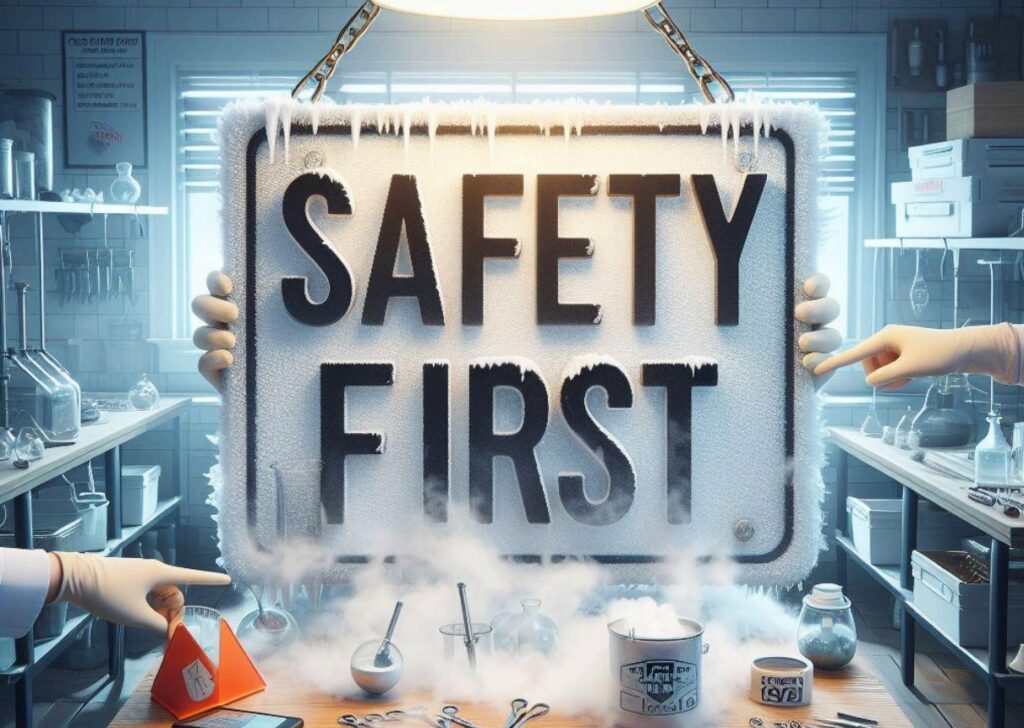Dry ice, with its myriad applications across various industries, is undeniably a powerful tool. However, its effectiveness hinges on its properties and how it is handled and stored. At Dry Ice UK, we prioritise safety above all else, ensuring that our customers have the knowledge and resources to handle and store dry ice safely and effectively.
Understanding Dry Ice Properties and Hazards
Before handling and using dry ice, users must thoroughly understand its properties and potential hazards. Dry ice is the solid form of carbon dioxide and sublimates directly from a solid to a gas at temperatures above -78.5°C. This sublimation process releases carbon dioxide gas, which can accumulate in confined spaces and displace oxygen, posing a risk of asphyxiation. Additionally, direct contact with dry ice can cause frostbite or skin burns due to its extreme cold temperature of -78.5°C. This knowledge enables users to implement appropriate precautions, establish safety procedures to mitigate potential incidents and respond promptly in an emergency. At Dry Ice UK, safety is ingrained in everything we do, from manufacturing to delivery.
Certifications Reflecting Commitment to Excellence
Dry Ice UK holds several certifications, including UKAS certification and ISO 45001:2018 Health and Safety Management Certification. These certifications reflect our unwavering commitment and dedication to the highest standards of excellence in health and safety management. Safety should never be compromised, and our certifications testify to our commitment to providing safe and reliable dry ice products and services to our customers.
Best Practices for Handling and Storing Dry Ice
Following best practices is essential to ensure safety and optimal performance when handling and storing dry ice. Here are some critical guidelines to keep in mind:
- Use Protective Gear: Always wear insulated gloves and safety goggles when handling dry ice to protect against frostbite and eye injuries.
- Ventilation: Ensure adequate ventilation in areas where dry ice is stored or used to prevent the buildup of carbon dioxide gas.
- Storage: Store dry ice in a well-ventilated container, such as a cooler or insulated box, to slow down the sublimation process and minimise the risk of gas buildup.
- Transportation: When transporting dry ice, use a well-insulated container and avoid sealing it completely to allow for the release of carbon dioxide gas.
- Disposal: Dry ice can be safely disposed of by allowing it to sublimate in a well-ventilated area or placing it in a container with warm water to accelerate the sublimation process. By adhering to these best practices, users can minimise the risk of accidents and ensure the safe and effective use of dry ice in their operations.
Conclusion
Safety is paramount when handling and storing dry ice. At Dry Ice UK, we are committed to providing our customers with the knowledge and resources to use dry ice safely and effectively. With our certifications and adherence to best practices, you can trust us to deliver high-quality dry ice products while prioritising the safety of our customers and the environment.
Ready to experience the unparalleled safety and quality of Dry Ice UK’s products and services? Whether you want to purchase dry ice for your business or need after-sales support, we’re here to help. Contact us today by calling 0800 084 2040 or emailing us at [email protected] to place your order or inquire about our comprehensive after-sales support options. With our commitment to excellence and dedication to safety, you can trust Dry Ice UK to meet all your dry ice needs. Reach out to us now, and let us assist you every step of the way.
